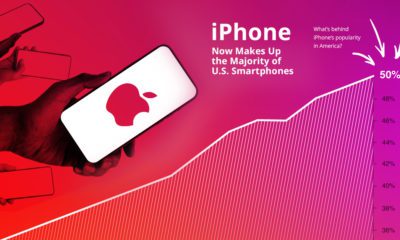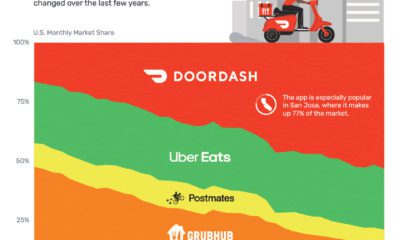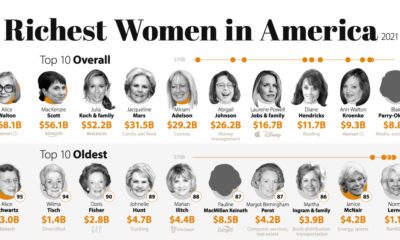Technology
How Technology is Shaping the Future of Consumer Credit
Consumer credit has been constantly evolving for more than 5,000 years, but the reality is that the most drastic changes to the industry came fairly recently.
Modern credit systems are now powered by sophisticated algorithmic credit scoring, the use of trended and alternative data, and innovative fintech applications. While these developments are all interesting in their own right, together they serve as a technological foundation for a much more profound shift in consumer credit in the coming years.
The Future of Consumer Credit
In today’s infographic from Equifax, we look at the cutting edge of consumer credit, including the new technologies and global trends that are shaping the future of how consumers around the world will access credit.
It’s the final piece of our three-part series covering the past, present, and future of credit.







The biggest problem that creditors have always faced is well-documented. There is more to a borrower than just their credit score. Yet creditors do not always have a 360 degree view of a consumer’s creditworthiness in order to better assess their overall score.
Called “information asymmetry”, this gap has gotten smaller over the years thanks to advancements in technology and business practices. However, it still persists in particular situations, like when a college student has no credit history, or when a rural farmer in India wants to take out a loan to buy seeds for crops.
But thanks to growing amounts of data – as well as the technology to make use of that data – high levels of information asymmetry may soon be a thing of the past.
Forces Shaping Credit’s Future
Here are some of the major forces that will drive the future of consumer credit, addressing the information asymmetry problem and making a wide variety of credit products available to the public:
1. Growing Data
90% of the data in all of human history has been created in just the last two years.
2. Changing Regulatory Landscape
New international regulations are putting personal data back in the hands of consumers, who can control the personal data they authorize access to.
3. Game-changing Technologies
Machine learning, deep learning, and neural networks are giving companies a way to garner insights from data.
4. Focus on Identity
Authenticating the identity of consumers will become crucial as credit becomes increasingly digital. Blockchain and biometrics could play a role.
5. The Fintech Boom
The democratization of data and tech is allowing small and niche players to come in and offer new, innovative products to consumers.
The Credit Revolution
No one can predict the future, but the above forces are shaping the credit industry to be a very different experience for consumers and businesses. Here are how things could change.
More Data, New Models
Current credit scoring algorithms use logistical regressions to compute scores, but these really max out at using 30-50 variables. In addition, these models can’t “learn” new things like AI can.
However, with new technologies and an unprecedented explosion in data taking place, it means that this noise can be converted into insights that could help increase trust in the credit marketplace. New algorithms will be multivariate, and they will be able to mine, structure, weight, and use this treasure trove of data.
| Technology | Description |
|---|---|
| Artificial intelligence | Machine learning can “learn” from massive data sets, and apply these lessons for better scoring. |
| Bayesian | Models can update probabilities as more information is available, helping to better predict creditworthiness. |
| APIs | Application programming interfaces (APIs) make it easier for developers to use technologies, data, and to build new applications. |
| Neural networks | Brain-inspired AI systems designed to replicate the way that humans learn are used for deep learning. This enables the processing of raw, unstructured, and often abstract data for new insights. |
Neural networks will be able to look at a billions of data points to find and make sense of extremely rare patterns. They will also be able to explain why a particular decision was made – and at a time where transparency is crucial, this will be key.
Data Will be in the Hands of Consumers
Today, much of consumers’ financial data – such as loan repayment histories – is held almost exclusively by banks and credit agencies.
However, tomorrow points to a very different paradigm: much of the data will be directly in the hands of consumers. In other words, consumers will be able to decide how their data gets used, and for what. In Europe, changes have already been made to transfer control of personal data to the consumer, such as the PSD2, GDPR, and Open Banking (U.K.) initiatives.
Experts see the trend towards open data growing globally, and eventually reaching the United States. Open data will allow consumers to:
- Regain control of checking, mortgage, loan, and credit card data
- Give up more information voluntarily to unlock better deals from creditors
- Grant access to third parties (fintech, apps, etc.) to use this data in new applications and products
- Gain access to better rates, new lending models, and more
Identity Will Be Just as Important
As transactions become more digital and remote, how lenders verify the identity of borrowers will be just as important as the lending data itself.
Why? Credit is based around trust – and fraud is the biggest risk for lenders.
But fraud an be prevented by new technologies that help detect anomalies and prove a borrower’s identity:
Blockchain
Distributed, tamper-resistant databases can help secure people’s identities from fraudulent activity
Biometrics
Fingerprints, facial recognition, and other biometric identification schemes could help secure identities as well
New Game, New Players
With the vast expansion in types and volume credit data, new technologies, and standardized data in the hands of consumers, there will be a new era of third-party companies and apps that can provide useful and relevant services for consumers.
Here are just some emerging fields in lending:
| Emerging fields | Description |
|---|---|
| P2P Loans | Does a bank need to be an intermediary? With peer-to-peer loans, you are matched to an appropriate lender/borrower. |
| Microlending | Lending doesn’t always need to be in big amounts, like for a mortgage or auto loan. |
| Alternative credit scoring | Psychometric testing or the use of other data streams can be used to power this less traditional form of lending. |
| Niche services | With an open playing field, companies will fill every gap imaginable. |
In the future, consumers may not have to even request credit – it may be automatically allocated to them based on behavior, age, assets, and needs.
Consumers will have more control, and more options than ever before.
Technology
All of the Grants Given by the U.S. CHIPS Act
Intel, TSMC, and more have received billions in subsidies from the U.S. CHIPS Act in 2024.

All of the Grants Given by the U.S. CHIPS Act
This was originally posted on our Voronoi app. Download the app for free on iOS or Android and discover incredible data-driven charts from a variety of trusted sources.
This visualization shows which companies are receiving grants from the U.S. CHIPS Act, as of April 25, 2024. The CHIPS Act is a federal statute signed into law by President Joe Biden that authorizes $280 billion in new funding to boost domestic research and manufacturing of semiconductors.
The grant amounts visualized in this graphic are intended to accelerate the production of semiconductor fabrication plants (fabs) across the United States.
Data and Company Highlights
The figures we used to create this graphic were collected from a variety of public news sources. The Semiconductor Industry Association (SIA) also maintains a tracker for CHIPS Act recipients, though at the time of writing it does not have the latest details for Micron.
| Company | Federal Grant Amount | Anticipated Investment From Company |
|---|---|---|
| 🇺🇸 Intel | $8,500,000,000 | $100,000,000,000 |
| 🇹🇼 TSMC | $6,600,000,000 | $65,000,000,000 |
| 🇰🇷 Samsung | $6,400,000,000 | $45,000,000,000 |
| 🇺🇸 Micron | $6,100,000,000 | $50,000,000,000 |
| 🇺🇸 GlobalFoundries | $1,500,000,000 | $12,000,000,000 |
| 🇺🇸 Microchip | $162,000,000 | N/A |
| 🇬🇧 BAE Systems | $35,000,000 | N/A |
BAE Systems was not included in the graphic due to size limitations
Intel’s Massive Plans
Intel is receiving the largest share of the pie, with $8.5 billion in grants (plus an additional $11 billion in government loans). This grant accounts for 22% of the CHIPS Act’s total subsidies for chip production.
From Intel’s side, the company is expected to invest $100 billion to construct new fabs in Arizona and Ohio, while modernizing and/or expanding existing fabs in Oregon and New Mexico. Intel could also claim another $25 billion in credits through the U.S. Treasury Department’s Investment Tax Credit.
TSMC Expands its U.S. Presence
TSMC, the world’s largest semiconductor foundry company, is receiving a hefty $6.6 billion to construct a new chip plant with three fabs in Arizona. The Taiwanese chipmaker is expected to invest $65 billion into the project.
The plant’s first fab will be up and running in the first half of 2025, leveraging 4 nm (nanometer) technology. According to TrendForce, the other fabs will produce chips on more advanced 3 nm and 2 nm processes.
The Latest Grant Goes to Micron
Micron, the only U.S.-based manufacturer of memory chips, is set to receive $6.1 billion in grants to support its plans of investing $50 billion through 2030. This investment will be used to construct new fabs in Idaho and New York.
-

 Lithium6 days ago
Lithium6 days agoRanked: The Top 10 EV Battery Manufacturers in 2023
-

 Green2 weeks ago
Green2 weeks agoTop Countries By Forest Growth Since 2001
-

 United States2 weeks ago
United States2 weeks agoRanked: The Largest U.S. Corporations by Number of Employees
-

 Maps2 weeks ago
Maps2 weeks agoThe Largest Earthquakes in the New York Area (1970-2024)
-

 Green2 weeks ago
Green2 weeks agoRanked: The Countries With the Most Air Pollution in 2023
-

 Green2 weeks ago
Green2 weeks agoRanking the Top 15 Countries by Carbon Tax Revenue
-

 Markets2 weeks ago
Markets2 weeks agoU.S. Debt Interest Payments Reach $1 Trillion
-

 Mining2 weeks ago
Mining2 weeks agoGold vs. S&P 500: Which Has Grown More Over Five Years?















